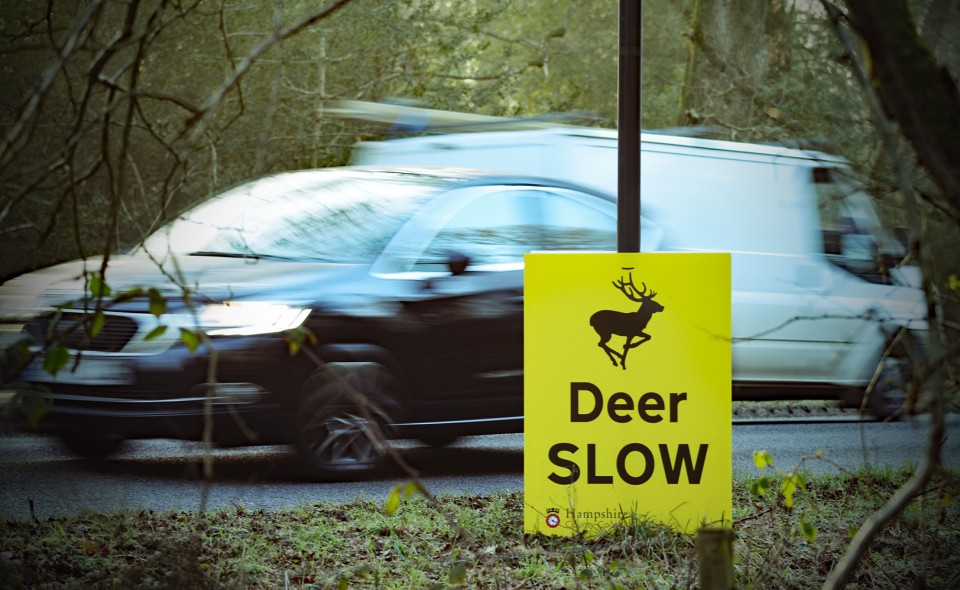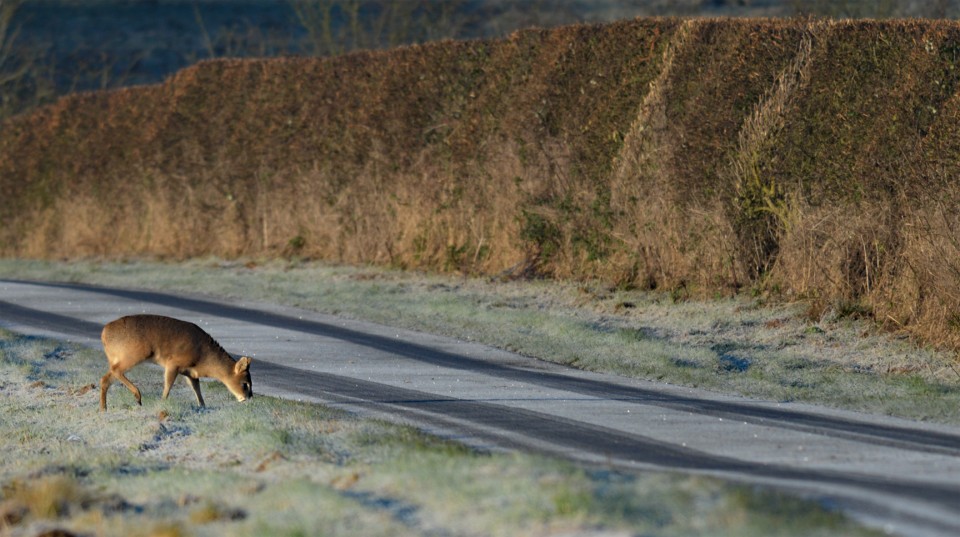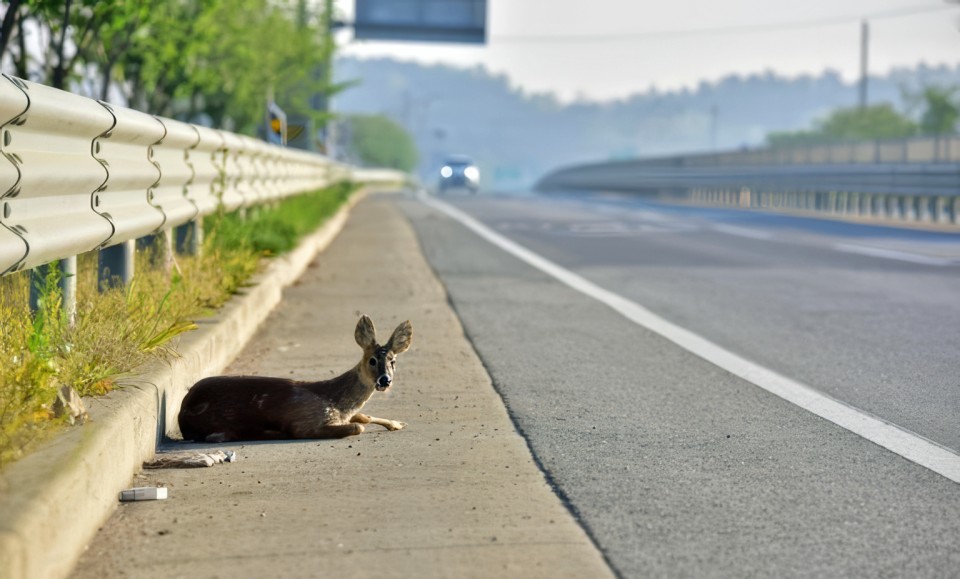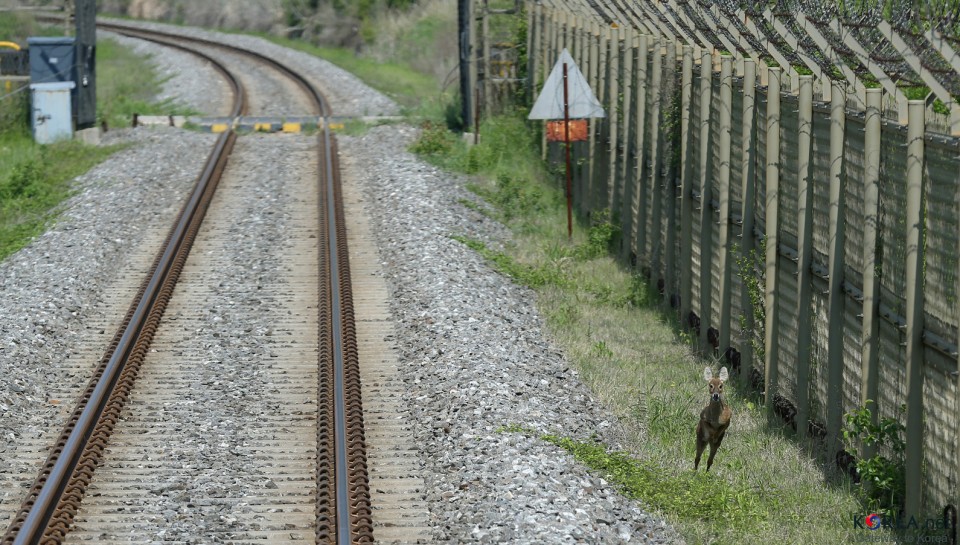Water Deer Interaction with Humans - Vehicle Collisions
As human populations continue to grow there is invariably an expansion of our towns and cities and the inevitable connectivity that brings, mostly in the form of roads. In Britain alone, statistics from the UK government state that we had just over 400,000 km (250,000 miles) of roads in 2021, nearly 4,800 km (3,000 mi.) more than a decade ago. Not only has the number of roads increased, so too has the volume of traffic on them, and collisions between wildlife and vehicles is a growing problem across much of the world.

While it is estimated that as many as 60,000 deer-vehicle collisions (DVCs) happen every year, a great many go unrecorded and even those that are reported seldom contain reliable species identification. Indeed, in 2019 Jochen Langbein told me that of the 95,000 DVC reports he has collected over the past 19 years for England, only 30,000 (32%) gave a species, and he's not confident about all of those. Nonetheless, of these 30,000 reports, 168 involve water deer. Jochen's dataset suggests at least 10 to 20 deer are hit by traffic each year in Britain, but this is indubitably a significant underestimate. The figure is also likely to be increasing regionally in line with the population growth and spread.
The localised distribution of water deer and their preferred habitat being away from major roads in many areas of England likely accounts for the species contributing just under 0.5% of reports where a species is given. Indeed, Martin Sanford at the Suffolk Biodiversity Information Service told me, in January 2024, that they have only two roadkill records in the county as their population in predominantly among coastal marshes and farmland. Conversely, in the Norfolk Bird & Mammal Report 2012, it was mentioned that reports of road-killed water deer made up 11% of total records for the species, higher than for any other species. Along a 10-mile stretch of A-road near Catfield, in the north-east of the county, 34 corpses were counted by S. Wright, accounting for 90% of DVC victims in the area. Arnold Cooke, in his 2019 Muntjac and Water Deer, noted that water deer are increasingly killed on roads in Cambridgeshire, while Sharon Scott has recorded several killed on the same stretch of busy road in rural Buckinghamshire in recent years. In Bedfordshire, I've personally seen very few road-killed deer around Woburn, despite having noted deer feeding in the verges at night and dawn on many occasions, but here they may have little reason to cross the main B5704 into Woburn, given the walled deer park opposite. Alternatively, I have seen several dashcam videos of water deer being hit by cars in South Korea having run into the road. Two of these clips involved deer running into the road at night and freezing in the path of the oncoming car, giving the impression they had been dazzled by the headlights as is known in some other species. If the response to being dazzled is to freeze, perhaps this prevents verge-side animals from straying onto the road in some cases? Daytime clips show the deer simply running across the road and seemingly either failing to notice, or misjudging the trajectory or speed of, passing cars.

I know of no data on water deer roadkill from China or North Korea, but, seemingly concomitant with their high densities, DVCs involving Hydropotes are apparently increasingly common in South Korea. Indeed, naturalist Junha Kim told me:
"Korean name of water deer is 'Gorani', and in Korean web sites gorani is also used as a slang for pedestrians, bicycles, and kickboard riders who cause traffic accidents due to careless behavior."
Supporting Junha's observation, an article to The Korean Times in October 2017 on an increase in the number of cyclists having been killed or injured by cars in South Korea, Park Moo-jong noted:
"A few days ago, I learned newly a coined Korean word from an article in a vernacular newspaper: "jarani" comprised of "ja" from "jajeongo" (bicycle) and "rani" from "gorani" (water deer). It means a cyclist who comes out in front of a car all of a sudden like the water deer. … The animal tends to dash into the light of vehicles at night rather than avoiding it, causing unexpected crashes with the cars at the risk of the wildlife."

Likewise, in an article to the same paper on the rise of e-scooters in Seoul, published during November 2020, the journalist wrote:
"… safety concerns about the vehicles are also growing, as seen in their notorious nickname "Kick-rani," a combination of the word kickboard and "gorani" -- a water deer in Korean -- that likens them to the wild animal that pops up out of nowhere on the road. "
In their 2019 paper to the International Journal of Environmental Research and Public Health, Jiyoung Choi and Sangdon Lee assessed data from the Korea Highway Corporation collected between 2009 and 2013. The researchers found that water deer was the most frequent roadkill species, accounting for 84.5% (9,078 animals). Interestingly, in their paper to the same journal during 2021, Minkyung Kim and colleagues extended the dataset, analysing nearly 37 thousand roadkill records from South Korean expressways between 2004 and 2019. They found that the numbers of animal-vehicle collisions fell during that period, although just over 28 thousand water deer were killed, accounting for 76.1% of the records. The authors note:
"Water deer is the most common wild animal species in Korea, and water deer roadkill is common along roads throughout Korea, including national roads, expressways, and smaller rural roads."
Overall, based on data from the South Korean government collected between 2011 and 2015, Tae-Young Choi estimated that at least 62,000 water deer are killed on the country's roads each year, which is about 1% of the population or roughly one deer per kilometre of road per year. An article to The Korea Times in May 2024 reported that May and June were the most dangerous months of the year for wild animals on Korean highways. The article quotes figures published by the state-funded Korea Expressway Corp (KEC) released earlier that month. The data show how nearly 40% of the 6,078 wildlife-vehicle collisions that happened over the previous five years occurred in these two months, nearly half of them between midnight and 08:00. The KEC figures also suggest that deer were involved in 84% of collisions, significantly more than any other species.
In his 2016 paper to Ecologically Resilient Infrastructure, Choi called for attention to be directed towards reducing the number of DVCs, which both the 2021 and 2024 data suggest is happening. Part of this mitigation is through fencing highways, and significant work has been undertaken by Hee-Bok Park and his colleagues to understand fencing requirements to keep water deer off roads. In a 2021 paper to the journal Sustainability, Park and his team concluded, based on studying 800 behavioural responses to fences over 40 trails at a test facility at the National Institute of Ecology in Seocheon-gun, that fences along roads should be at least 1.2 metres (4 ft.) and ideally 1.5 m (5ft.) tall to deter Korean water deer from jumping over them, although some individuals managed to clear fences up to 1.8 m (6 ft.). Curiously, in his account of the water deer in the Deer of the World compendium, published in 2025, Baek-Jun Kim noted that, based on his personal observation, they "can jump up higher than 5 m in an emergency". Presumably this is a typo, and it should say 5 ft, as 5 m (16 ft.) seems improbable? Regardless, in a paper to the Korean Journal of Veterinary Service during 2021, Bae Dong Jung and colleagues at Kangwon National University reported how, based on roadkill reports, animals taken to rescue centres and a single GPS-tracked female water deer, fences along South Korean roads could deter crossings if they were high enough, and the authors recommended planning roads through woodland and agricultural landscapes with both appropriate fencing and a suitable speed limit. The 2024 Korea Times article suggested that, thanks to a combination of fences and wildlife crossings installed by the KEC, the number of accidents involving wild animals fell from 2,545 in 2015 to 978 in 2023.

As well as dying under the wheels of cars, it appears water deer are also occasionally hit by trains, although this seems uncommon. In the Norfolk Bird & Mammal Report 2012, Andy Musgrove noted a casualty on the train tracks at Strumpshaw. More recently, in September 2025 I submitted a Freedom of Information request to Network Rail (FOI2025/01623) asking for details of any collisions with water deer on their network in East Anglia and the Home Counties over the past 10 years, which returned no results in their database, despite records existing for red, roe and muntjac deer in the same timeframe. In South Korea, a June 2015 article in The Korean Times reported that a high-speed Korea Train eXpress (KTX) train travelling from Busan to Seoul was damaged after hitting a water deer near Osong Station in North Chungcheong Province at around 00:30. This was apparently the first time a KTX train had been damaged in a collision with a vehicle, although the article doesn't specify whether collisions that don't result in damage have occurred previously. I have seen many images of water deer near the railway tracks in the Civilian Control Zone and, given their flighty nature, it seems the potential for collision is significant.